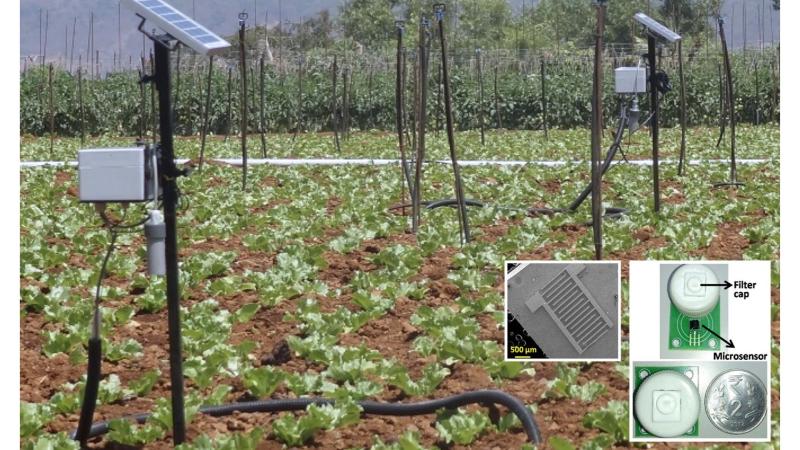
Researchers develop a stable low-cost microsensor from graphene oxide to measure soil moisture on field
Agriculture uses 80% of the usable water in India. However, almost half of it is wasted due to inefficient irrigation systems—a scenario to be avoided as water is getting scarce. Plants get nutrition from the nutrients dissolved in the soil moisture, and they grow best in soil that has optimal moisture. Farmers need to examine the ground at regular intervals to check the moisture level—a task that could be very tedious in large farms.
Researchers from the Indian Institute of Technology Bombay (IIT Bombay) seem to have a technological solution to this problem. Led by Prof Maryam Shojaei Baghini, researchers from IIT Bombay and Gauhati University, have designed a robust, accurate and affordable soil moisture sensor using graphene oxide. The sensor detects small changes in soil moisture and is not affected by changes in the temperature and salt content of the soil. It is also stable, giving consistent measurement over a long time. When mass produced, these sensors could cost about ₹2000, which is 40 to 50 times cheaper than other sensors available in the market. These features make the sensor lucrative for use, especially in large farms.
When the moisture content changes, various electrical properties of the soil also change. For example, electrical resistance decreases when the soil contains more moisture. Currently available commercial sensors use one of these properties to measure soil moisture. However, moisture values measured using such sensors vary when temperature changes, and need compensation. Another type of sensor uses a technique called time-domain reflectometry or TDR, which uses properties of the soil that vary according to the frequency of the electrical signal applied. Although stable, such sensors are expensive and could cost anywhere between ₹80,000 to ₹1,50,000. Large farms would need many such sensors to cover the entire area, and hence, such sensors are not practical. Microsensors, which use conductive polymers, cost less but have low stability, low sensitivity and are not durable.
The researchers of the current study wanted to explore the use of graphene oxide for the measurement of soil moisture. Graphene is a form of carbon that is a single-molecule-thick sheet and is a very widely studied nano-material for sensors. Single sheet materials offer a greater surface area for molecules to bind and hence, have high sensitivity. Graphene oxide, a derivative of graphene, is also a single sheet material. It is an insulator, and its capacitance varies with the moisture content. The researchers used graphene oxide to make a capacitive microsensor.
The researchers fabricated the graphene oxide microsensors using MEMS technology. MEMS or Microelectromechanical systems are miniature systems that contain microsensors, microactuators and mechanical as well as electrical components. They are a few micrometres to a few millimetres in size and can be precisely fabricated with low cost.
“Advancement in MEMS technologies has made microsensor fabrication better and affordable. This can help to scale up the number of sensors for large farms,'' explains Dr Vinay Palaparthy, one of the authors of this study.
The sensor consists of a silicon oxide substrate, with electrodes shaped like prongs on a fork on its surface. The prongs of the two electrodes alternate with each other. A layer of graphene oxide, deposited between the prongs, acts as the sensing element. The whole assembly is covered with a three-layered mesh to allow only moisture to come in contact with the sensor and keep contaminants away.
The researchers first tested the sensor by measuring the relative humidity in a test chamber. They expected that the sensor’s response to soil moisture would be similar to its response to relative humidity as both measure water content. They kept the sensor in a chamber and recorded the sensor’s capacitance values for different concentrations of water vapour. The capacitance of the sensor changed by about 1200% as the relative humidity varied from 50% to 94%.
The team used the graphene oxide sensor to measure the soil moisture in samples of red and black soil collected from the field. The capacitance of the sensor changed by 340% for red soil and 370% for black cotton soil when the soil moisture changed from 1% to 55%. This change in capacitance followed a pattern similar to the change in capacitance with the relative humidity. They found that the sensor was quick, accurate and stable for more than four months of continuous operation, making them viable for use during one crop cycle. The researchers are now exploring the use of these microsensors for multiple crop cycles.
To find out how the sensors responded to change in temperature, the researchers kept the moisture content in the soil constant and varied the temperature from 25 °C to 65 °C. They recorded a change of merely 6% in the sensor output. For a salt concentration variation from 0M (moles) to 0.35M, the sensor output changed by 4%.
An array of soil moisture sensors can make automated irrigation of large farms easy and efficient. Graphene oxide-based sensors, like the ones developed in this study, look promising as they are inexpensive. With extensive field testing and improved packaging, these sensors will be suitable for commercialisation, say the researchers.
This article has been run past the researchers, whose work is covered, to ensure accuracy.






